|
|
Family Tessaratomidae - Large Stink Bugs
Family Tessaratomidae is a small family very close to family Pentatomidae. Members in this family look like pentatomid. They are large in size and with relatively small head. We found one species of family in Brisbane.
Bronze Orange Bug - Musgraveia sulciventris
- This page contains pictures and information about Bronze Orange Bugs that we found in the Brisbane area, Queensland, Australia.
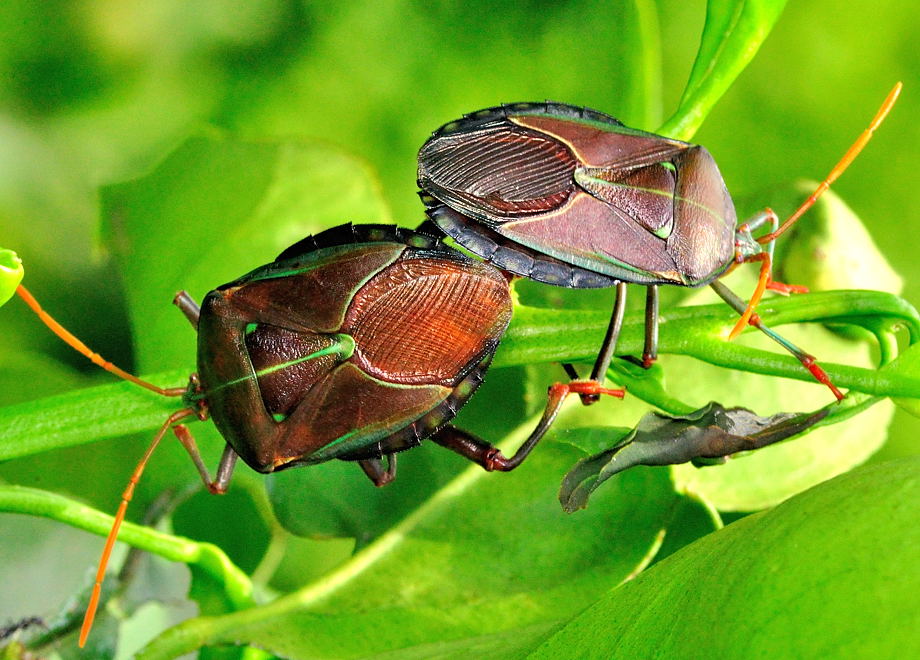
- Body length 25mm
- Bronze Orange Bugs are very large stink bugs. Their body is fat and thick. They are dark bronze in colour with triangular back plate (scutellum). Their head is relatively small, with antenna orange in colour. Their legs are blue-green in colour with orange joints.
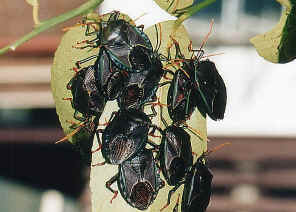
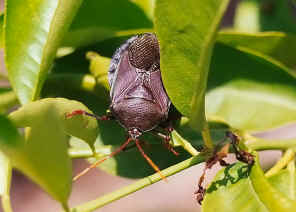
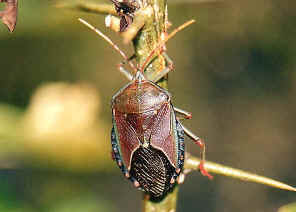
- They are slow moving, usually stay at the same spot for a few days. In early summer, Bronze Orange Bugs can be found in a large number on Citrus plants (oranges, lemons and limes etc.). Usually nymphs and adults can be found on the same plants.
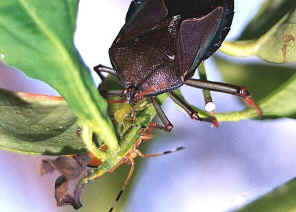

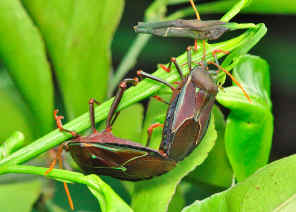
- They suck sap from young shoots of of the plants. The first and second pictures above show the bugs sucking the juice from the new shot of the Citrus plant. Notice their sucking mouth-parts and the wilted tips of the plant. The 3rd picture shows the mating couple. After mating the females lay eggs on leaf for the next generations.
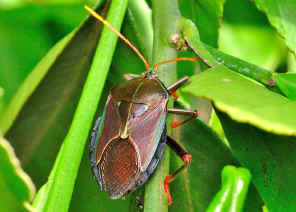
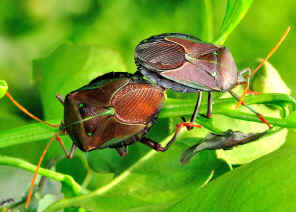
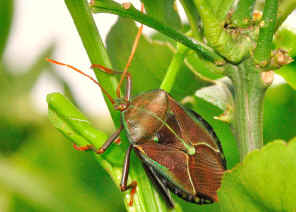
- They have flat and soft bodies. Their forewings are toughen on the base area and with a membranous tip part. Their antennae are well developed with five segments.
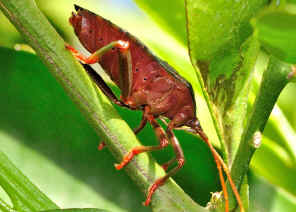

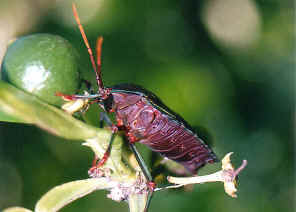
- In the pictures above, also notice the small hole at the side of the bug body, between the middle and hind legs, is the outlet of the stinky liquid. The other holes on each segments of its abdomen are the spiracle which the insect used for breathing.
-
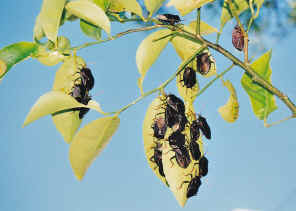
- The Bronze Orange Bugs is considered as a minor pest of citrus.
Eggs and Nymphs
- The Bronze Orange Bug eggs are large, pale green in colour. They were laid neatly under the leaves of host plants, usually new grown leaves. We had seen several batches of their eggs and the number of eggs is always fourteen. Eggs are globular in diameter of 2.5mm. From reference infromation, each female may lay up to four batches of eggs.
- As all other stick bugs, the Bronze Orange Bugs have five nymphal instars stages.
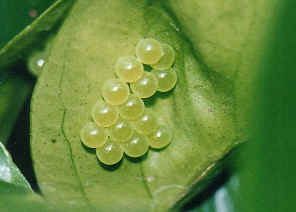
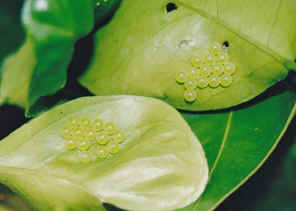
- Eggs diameter 2.5mm
-
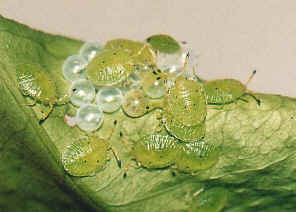
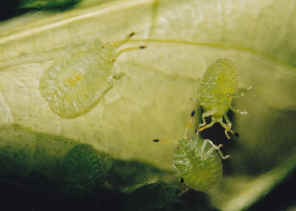
- 1st instars body length 5mm 2nd instars body length 7mm
- In above photos the batch of eggs was found on Nov 2002. After about a week, the small bugs hatched, They were also pale green in colour. They stayed together near the egg-shells.
- The 1st instars stage of this bug does not feed.
- Two or three days later, we saw their first moulting. The 2nd instars looked the same except larger in body size. They stayed on a young citrus leaf and started sucking the sap.
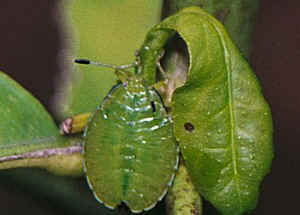
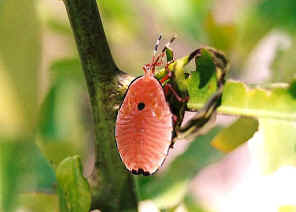
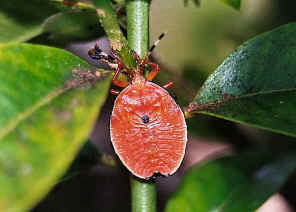
- 3rd instars Nymph, 10mm. 4th instars Nymph, 15mm
- The Bronze Orange Bug nymphs reassemble citrus leaves. They camouflaged so well that for this small nymph in the second picture above, we did not see it when we were taking the photos. We found it on the picture only after we developed the pictures from films.
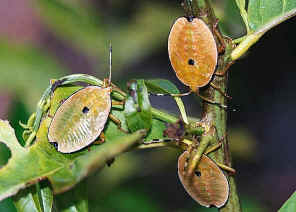
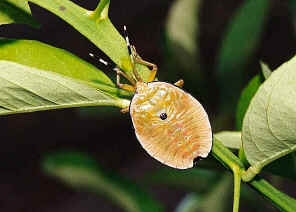
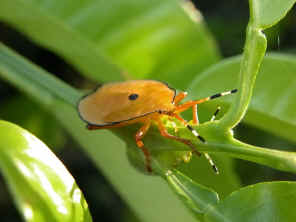
- 4th instars Nymph, 15mm
- The 4th and 5th instars individuals may have different colours, vary from yellow-green to pale brown-orange. During mid summer Nov to Jan in Brisbane, we saw all different stages instars and adults on the same plant.
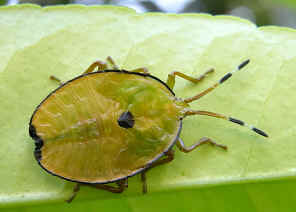
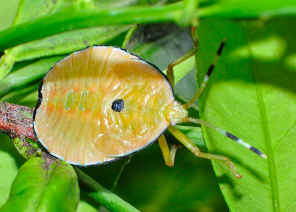
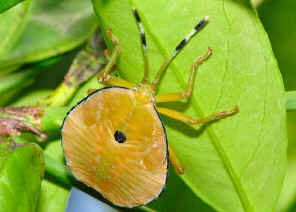
- 5th instars Nymph, 20mm
- The nymphs have flatted edge and oval in shape. Notice the black dot and darken edges on their back reassemble the markings that they made on the host leaves.
- Their body colours change from camouflage colour to warning colour.
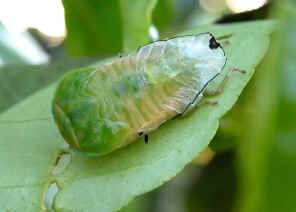
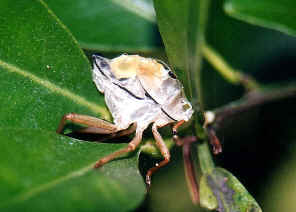
- After the last moulting, the bug becomes an adults. The pictures above shows the moulting nymph and the empty skin shell leave after the moulting.
Stink Secretion
- The Bronze Orange Bugs are famous in producing stink secretion. We took high caution when we were taking these pictures. We moved slowly and dared not came too close. Even so, after taking a few pictures, We sensed the strong stinky smell and found that there were the brown markings on our hands and cloths. There were adults and nymphs bugs on the plants. We did not know when or which bugs did it. The smell was removed after a few times washing with soap, but the brown markings stayed on our skin for the whole week.
- The odor is from the discharged fluid which contains an oily component cimicine, which is a very volatile component.
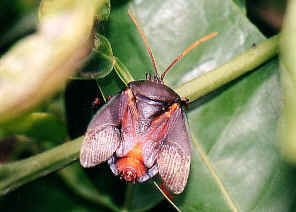
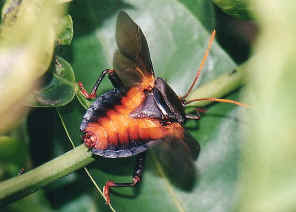
- The Bronze Orange Bugs are slow moving and we never see them flying. We believed they are not the good flier. The about pictures show the bug flapped its wings. The bug was not about to take off but to scare away the small flies that annoying it. Notice the bright orange pattern on the back of its abdomen.
- (Our visitors sent us emails advised that they do fly: "well they do fly very well, and when disturbed they fly off and around and return to the tree." )
- Many visitors sent us emails about this bug and asked how to get rid of them. Well, we do not know ......or please check our FAQ question number 2.
- Reference:
- 1. Insects of Australia, CSIRO, Division of Entomology, Melbourne University Press, 2nd Edition 1991, p 508.
- 2. Insects of Australia, Hangay, George, & German, Pavel, Reed New Holland, Sydney, 2000, pp 65.
- 3. Musgraveia sulciventris - Australian Biological Resources Study, Department of the Environment and Heritage, Commonwealth of Australia 2005.
- 4. TESSARATOMIDAE Tessaratomid bugs - Save Our Waterways Now, 2008.
- 5. Life-cycle of the bronze orange bug Musgraveia sulciventris (Stal) (Hemiptera : Tessaratomidae) - FJD McDonald, 1969, Australian Journal of Zoology 17(5) 817 - 820.
- 6. The Insects of Australia and New Zealand - Tillyard, R.J. 1926, Sydney : Angus & Robertson Ltd, p148.
